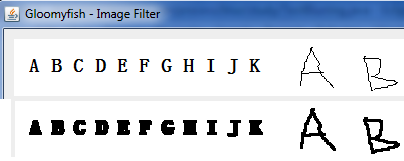基本原理:
膨胀是图像形态学的两个基本操作之一,另外一个是腐蚀操作。最典型的应用是在二值图像
中使用这两个基本操作,是很多识别技术中重要的中间处理步骤。在灰度图像中根据阈值同
样可以完成膨胀与腐蚀操作。对一幅二值图像f(x,y)完成膨胀操作,与对图像的卷积操作类
似,要有个操作数矩阵,最常见的为3X3的矩阵,与卷积操作不同的,是如果矩阵中的像素
点有任意一个点的值是前景色,则设置中心像素点为前景色,否则不变。
程序效果:(上为源图,下为膨胀以后效果)

程序原理:
首先把一幅彩色图像转换为灰度图像,转换方法参见这里
http://blog.csdn.net/jia20003/article/details/7392325
然根据像素平均值作为阈值,转换为二值图像,转换方法参见这里
http://blog.csdn.net/jia20003/article/details/7392325
最后在二值图像上使用膨胀操作,输出处理以后图像
源代码:
- package com.gloomyfish.morphology;
- import java.awt.Color;
- import java.awt.image.BufferedImage;
- public class DilateFilter extends BinaryFilter {
- public DilateFilter() {
- forgeColor = Color.WHITE;
- }
- private Color forgeColor;
- public Color getForgeColor() {
- return forgeColor;
- }
- public void setForgeColor(Color forgeColor) {
- this.forgeColor = forgeColor;
- }
- @Override
- public BufferedImage filter(BufferedImage src, BufferedImage dest) {
- int width = src.getWidth();
- int height = src.getHeight();
- if ( dest == null )
- dest = createCompatibleDestImage( src, null );
- int[] inPixels = new int[width*height];
- int[] outPixels = new int[width*height];
- src = super.filter(src, null); // we need to create new one
- getRGB( src, 0, 0, width, height, inPixels );
- int index = 0, index1 = 0, newRow = 0, newCol = 0;
- int ta1 = 0, tr1 = 0, tg1 = 0, tb1 = 0;
- for(int row=0; row<height; row++) {
- int ta = 0, tr = 0, tg = 0, tb = 0;
- for(int col=0; col<width; col++) {
- index = row * width + col;
- ta = (inPixels[index] >> 24) & 0xff;
- tr = (inPixels[index] >> 16) & 0xff;
- tg = (inPixels[index] >> 8) & 0xff;
- tb = inPixels[index] & 0xff;
- boolean dilation = false;
- for(int offsetY=-1; offsetY<=1; offsetY++) {
- for(int offsetX=-1; offsetX<=1; offsetX++) {
- if(offsetY==0 && offsetX==0) {
- continue;
- }
- newRow = row + offsetY;
- newCol = col + offsetX;
- if(newRow <0 || newRow >=height) {
- newRow = 0;
- }
- if(newCol < 0 || newCol >=width) {
- newCol = 0;
- }
- index1 = newRow * width + newCol;
- ta1 = (inPixels[index1] >> 24) & 0xff;
- tr1 = (inPixels[index1] >> 16) & 0xff;
- tg1= (inPixels[index1] >> 8) & 0xff;
- tb1 = inPixels[index1] & 0xff;
- if(tr1 == forgeColor.getRed() && tg1 == tb1) {
- dilation = true;
- break;
- }
- }
- if(dilation){
- break;
- }
- }
- if(dilation) {
- tr = tg = tb = forgeColor.getRed();
- } else {
- tr = tg = tb = 255 - forgeColor.getRed();
- }
- outPixels[index] = (ta << 24) | (tr << 16) | (tg << 8) | tb;
- }
- }
- setRGB( dest, 0, 0, width, height, outPixels );
- return dest;
- }
- }
1. 对一副黑白的图像完成膨胀操作
2.将膨胀以后的图像与原来的图像在每个像素位上相减
3.显示相减以后的图像,即得到边缘。
版权声明:本文为博主原创文章,未经博主允许不得转载。